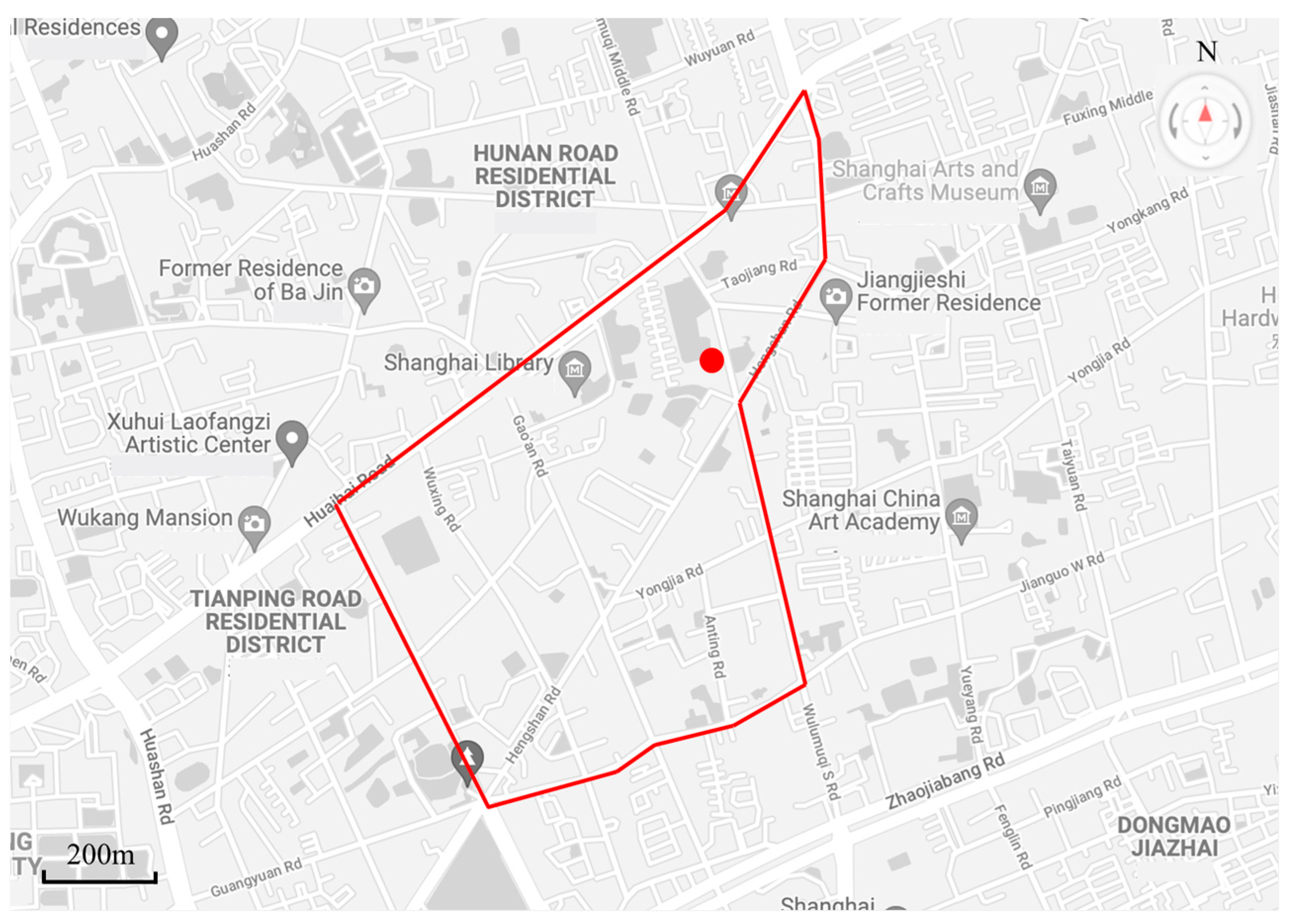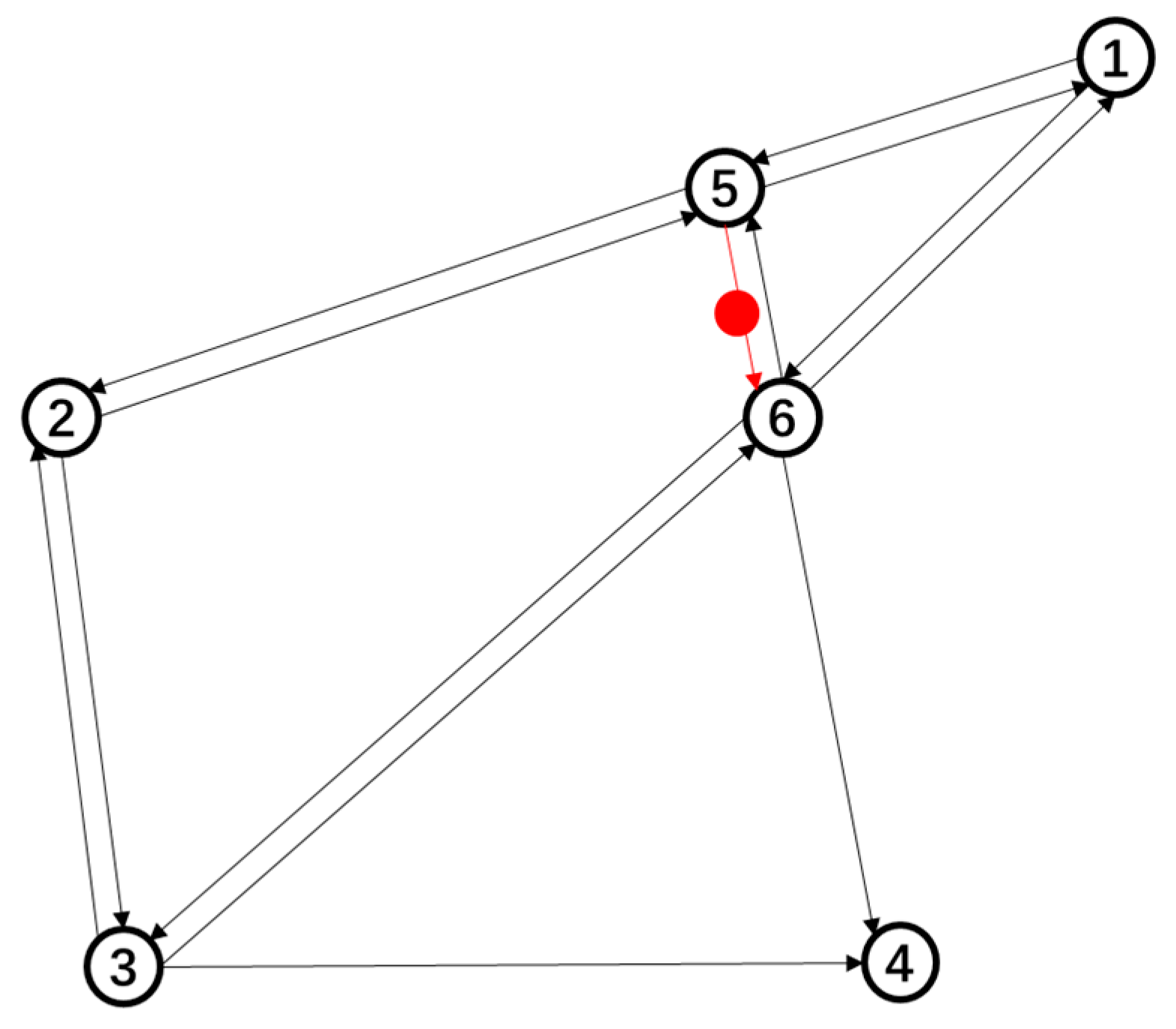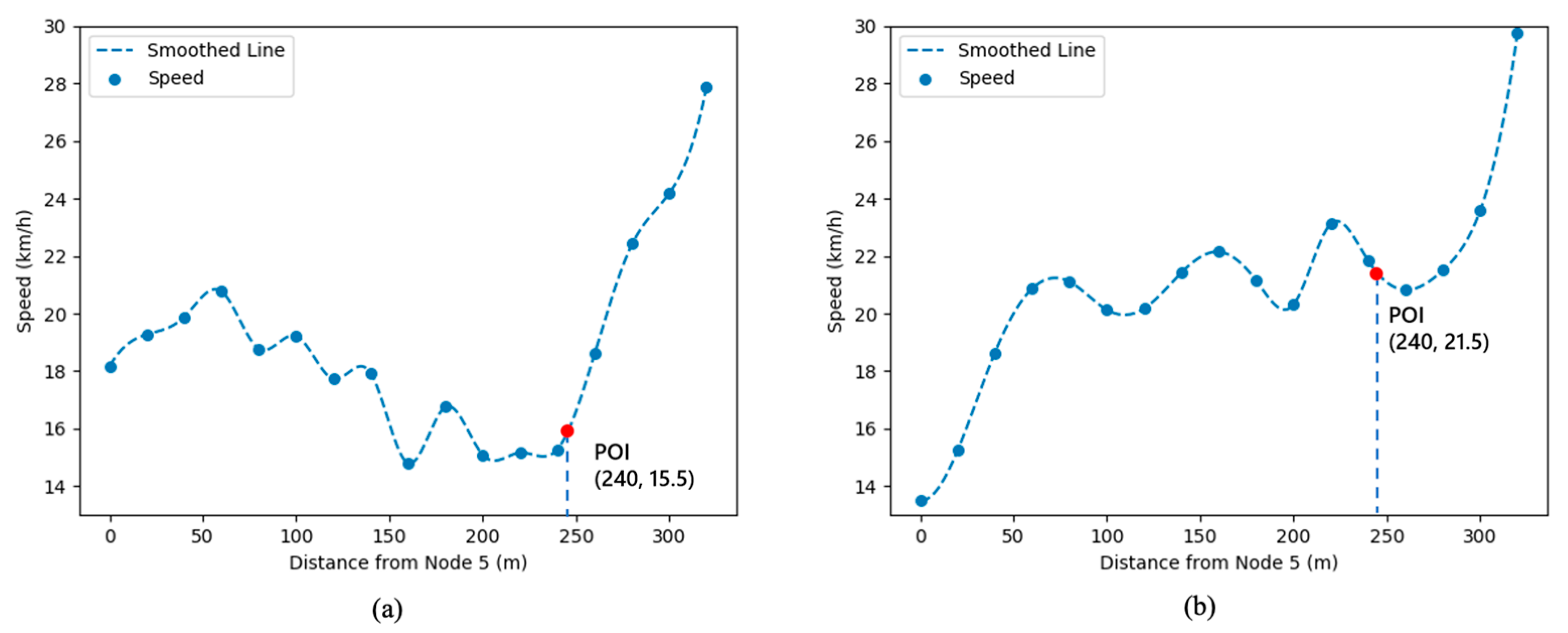Dynamic Traffic Assignment Model Based on GPS Data and Point of Interest (POI) in Shanghai
Abstract
:1. Introduction
2. Materials and Methods
- Determine the initial value. Initial point , given an error , ;
- Solve the approximate linear programming: , to obtain the optimal solution ;
- Construct feasible descent directions, let , if , stop the computation and output ; otherwise go to the next step.
- One-dimensional search: to get step . Let , updated to , go to the second step.
3. Experiments
3.1. Data Description
3.2. Performance Indexes
4. Interpretation of Results
4.1. The Results of POI Impact
4.1.1. Qualitative Analysis
4.1.2. Qualitative Analysis
4.2. The Results of User Equilibrium Model
5. Conclusions
Author Contributions
Funding
Institutional Review Board Statement
Informed Consent Statement
Data Availability Statement
Conflicts of Interest
References
- Shanghai Research Institute. 2020 Shanghai Comprehensive Transportation Annual Report; Shanghai Research Institute of Urban-Rural Construction and Transportation Development: Shanghai, China, 2020. [Google Scholar]
- 2019 Annual Traffic Analysis Report for Major Cities in China; Amap.com, State Information Center, Joint Laboratory for Future Transport and Urban Computing et al.: Beijing, China, 2019.
- Ashfaq, M.; Gu, Z.; Waller, S.T.; Saberi, M. Comparing Dynamic User Equilibrium and Noniterative Stochastic Route Choice in A Simulation-Based Dynamic Traffic Assignment Model: Practical Considerations for Large-Scale Networks. J. Adv. Transp. 2021, 2021, 6667335. [Google Scholar] [CrossRef]
- Fujita, M.; Yamada, S.; Murakami, S. Time Coefficient Estimation for Hourly Origin-Destination Demand from Observed Link Flow Based on Semidynamic Traffic Assignment. J. Adv. Transp. 2017, 2017, 6495861. [Google Scholar] [CrossRef]
- De Grange, L.; Marechal, M.; Gonzalez, F. A Traffic Assignment Model Based on Link Densities. J. Adv. Transp. 2019, 2019, 5282879. [Google Scholar] [CrossRef]
- Marshall, N.L. Forecasting the Impossible: The Status Quo Of Estimating Traffic Flows with Static Traffic Assignment and the Future of Dynamic Traffic Assignment. Res. Transp. Bus. Manag. 2018, 29, 85–92. [Google Scholar] [CrossRef]
- Kerner, B.S. Breakdown Minimization Principle Versus Wardrop’s Equilibria for Dynamic Traffic Assignment and Control in Traffic and Transportation Networks: A Critical Mini-Review. Phys. A Stat. Mech. its Appl. 2017, 466, 626–662. [Google Scholar] [CrossRef]
- Wang, Y.; Szeto, W.Y.; Han, K.; Friesz, T.L. Dynamic Traffic Assignment: A Review of The Methodological Advances for Environmentally Sustainable Road Transportation Applications. Transp. Res. Part B Methodol. 2018, 111, 370–394. [Google Scholar] [CrossRef]
- Raadsen, M.P.H.; Bliemer, M.C.J.; Bell, M.G.H. Aggregation, Disaggregation and Decomposition Methods in Traffic Assignment: Historical Perspectives and New Trends. Transp. Res. Part B Methodol. 2020, 139, 199–223. [Google Scholar] [CrossRef]
- Papamichail, I.; Bekiaris-Liberis, N.; Delis, A.I.; Manolis, D.; Mountakis, K.-S.; Nikolos, I.K.; Roncoli, C.; Papageorgiou, M. Motorway Traffic Flow Modelling, Estimation and Control With Vehicle Automation and Communication Systems. Annu. Rev. Control. 2019, 48, 325–346. [Google Scholar] [CrossRef]
- Chiu, Y.-C.; Bottom, J.; Mahut, M. Dynamic Traffic Assignment: A Primer; Transportation Research Board of the national academies: Birsbane, Australia, 2011. [Google Scholar]
- Merchant, D.K.; Nemhauser, G.L. A Model and An Algorithm for the Dynamic Traffic Assignment Problems. Transp. Sci. 1978, 12, 183–199. [Google Scholar] [CrossRef]
- Friesz, T.L.; Luque, J.; Tobin, R.L.; Wie, B.-W. Dynamic Network Traffic Assignment Considered as A Continuous Time Optimal Control Problem. Oper. Res. 1989, 37, 893–901. [Google Scholar] [CrossRef]
- Meng, M.; Shao, C.; Wong, Y.D.; Zhang, J. A Multiclass, Multimodal Dynamic Traffic Assignment Model with Departure Time. Math. Probl. Eng. 2014, 2014, 812614. [Google Scholar] [CrossRef]
- Zhao, C.-L.; Leclercq, L. Graphical Solution for System Optimum Dynamic Traffic Assignment with Day-Based Incentive Routing Strategies. Transp. Res. Part B Methodol. 2018, 117, 87–100. [Google Scholar] [CrossRef] [Green Version]
- Elimadi, M.; Abbas-Turki, A.; Koukam, A. A Novel Approach for Dynamic Traffic Assignment Based on Multi-Agent Node Reservation: Comparative Study on Two Competing Roads. Procedia Comput. Sci. 2021, 191, 320–327. [Google Scholar] [CrossRef]
- Zhang, H.; Seshadri, R.; Prakash, A.A.; Antoniou, C.; Pereira, F.C.; Ben-Akiva, M. Improving the Accuracy and Efficiency of Online Calibration for Simulation-Based Dynamic Traffic Assignment. Transp. Res. Part C Emerg. Technol. 2021, 128, 103195. [Google Scholar] [CrossRef]
- Banadaki, H.D.; Saffarzadeh, M.; Zoghi, H. Developing a Dynamic Traffic Assignment Model for Large-Scale Networks: A Case Study in the City of Yazd, Iran. KSCE J. Civ. Eng. 2021, 25, 3492–3501. [Google Scholar] [CrossRef]
- Lu, Q.; Tettamanti, T. Traffic Control Scheme for Social Optimum Traffic Assignment with Dynamic Route Pricing for Automated Vehicles. Period. Polytech. Transp. Eng. 2021, 49, 301–307. [Google Scholar] [CrossRef]
- Aghamohammadi, R.; Laval, J.A. Dynamic Traffic Assignment Using The Macroscopic Fundamental Diagram: A Review of Vehicular and Pedestrian Flow Models. Transp. Res. Part B Methodol. 2020, 137, 99–118. [Google Scholar] [CrossRef] [Green Version]
- Kamel, I.; Shalaby, A.; Abdulhai, B. Integrated Simulation-Based Dynamic Traffic and Transit Assignment Model for Large-Scale Network. Can. J. Civ. Eng. 2020, 47, 898–907. [Google Scholar] [CrossRef]
- Hu, T.Y.; Tong, C.C.; Liao, T.Y.; Chen, L.W. Dynamic Route Choice Behaviour and Simulation-Based Dynamic Traffic Assignment Model for Mixed Traffic Flows. J. Civ. Eng. 2017, 22, 1–10. [Google Scholar] [CrossRef]
- Zhang, H.; Zhang, Q.; Yang, L. A User Equilibrium Assignment Flow Model for Multiairport Open Network System. Math. Probl. Eng. 2015, 2015, 631428. [Google Scholar] [CrossRef] [Green Version]
- Zhang, Y.; Atasoy, B.; Akkinepally, A.; Ben-Akiva, M. Dynamic Toll Pricing Using Dynamic Traffic Assignment System with Online Calibration. Transp. Res. Rec. 2018, 2673, 532–546. [Google Scholar] [CrossRef]
- Mou, N.; Li, J.; Zhang, L.; Liu, W.; Xu, Y. Spatio-Temporal Characteristics of Resident Trip Based on POI and OD Data of Float Car in Beijing. ISPRS-Int. Arch. Photogramm. Remote. Sens. Spat. Inf. Sci. 2017, XLII-2/W7, 99–105. [Google Scholar] [CrossRef] [Green Version]
- Barlacchi, G.; Lepri, B.; Moschitti, A. Land Use Classification with Point of Interests and Structural Patterns. IEEE Trans. Knowl. Data Eng. 2021, 33, 3258–3269. [Google Scholar] [CrossRef]
- Niu, H.; Silva, E.A. Delineating Urban Functional Use from Points of Interest Data With Neural Network Embedding: A Case Study in Greater London. Comput. Environ. Urban Syst. 2021, 88, 101651. [Google Scholar] [CrossRef]
- Wang, Z.; Ma, D.; Sun, D.; Zhang, J. Identification and Analysis of Urban Functional Area in Hangzhou Based on OSM and POI Data. PLoS ONE 2021, 16, e0251988. [Google Scholar] [CrossRef]
- Zhang, T.; Sun, L.; Yao, L.; Rong, J. Impact Analysis of Land Use on Traffic Congestion Using Real-Time Traffic and POI. J. Adv. Transp. 2017, 2017, 7164790. [Google Scholar] [CrossRef] [Green Version]
- Gauglitz, P.; Geiger, D.; Ulffers, J.; Zauner, E. Modeling Public Charging Infrastructure Considering Points of Interest and Parking Potentials. Adv. Geosci. 2021, 56, 1–12. [Google Scholar] [CrossRef]
- Chen, Q.; Ye, T.; Zhao, N.; Ding, M.; Ouyang, Z.; Jia, P.; Yue, W.; Yang, X. Mapping China’s Regional Economic Activity by Integrating Points-of-Interest and Remote Sensing Data with Random Forest. Environ. Plan. B Urban Anal. City Sci. 2021, 48, 1876–1894. [Google Scholar] [CrossRef]
- Wei, Z.; Fu, C.W.; Arisona, S.M.; Schubiger, S.; Burkhard, R.; Ma, K.L. Visualizing the Relationship Between Human Mobility and Points of Interest. IEEE Trans. Intell. Transp. Syst. 2017, 18, 2271–2284. [Google Scholar]
- Xu, Z.; Cui, G.; Zhong, M.; Wang, X. Anomalous Urban Mobility Pattern Detection Based on GPS Trajectories and POI Data. ISPRS Int. J. Geo-Inf. 2019, 8, 308. [Google Scholar] [CrossRef] [Green Version]
- Yiyong, P.; Ting, Y.; Jianxiao, M. Improvement of Urban Road Impedance Function Based on Section Impedance and Node Impedance. J. Chongqing Jiaotong Univ. (Nat. Sci.) 2017, 36, 80–85. [Google Scholar]






| Figure 3 | Flow | Congestion Level | Description |
|---|---|---|---|
| (a) | 33 | Light | The red area of the link is small, and the road congestion is light. |
| (b) | 65 | Heavy | The red area of the link is increasing, which means that parent pick-up vehicles are gathering. |
| (c) | 52 | Heavy | The red area of the link decreases, because the parents’ pick-up vehicles are parked in front of the kindergarten waiting for the children to be released. The speed is null and is not counted in the track data, and this type of data points is not shown on the heat map. |
| (d) | 71 | Heavy | The red area of the link increases as most of the parents have received their children. There is a short period of congestion caused by them leaving the link. |
| (e) | 46 | Light | The red area of the link decreases, and the road is reopened. |
| No. of Link | Link | Length (km) | Free Time (s) | Capacity | Flow | V/C |
|---|---|---|---|---|---|---|
| 1 | [‘1’, ‘5’] | 0.41 | 0.0068 | 2000 | 213 | 0.106 |
| 2 | [‘1’, ‘6’] | 0.62 | 0.0103 | 2000 | 159 | 0.08 |
| 3 | [‘2’, ‘5’] | 0.84 | 0.014 | 2000 | 125 | 0.062 |
| 4 | [‘2’, ‘3’] | 0.64 | 0.0107 | 1000 | 104 | 0.104 |
| 5 | [‘3’, ‘2’] | 0.64 | 0.0107 | 1000 | 48 | 0.048 |
| 6 | [‘3’, ‘6’] | 0.93 | 0.0155 | 2000 | 75 | 0.038 |
| 7 | [‘3’, ‘4’] | 0.67 | 0.0112 | 1000 | 47 | 0.047 |
| 8 | [‘5’, ‘2’] | 0.84 | 0.014 | 2000 | 244 | 0.122 |
| 9 | [‘5’, ‘1’] | 0.41 | 0.0068 | 2000 | 89 | 0.044 |
| 10 | [‘5’, ‘6’] | 0.32 | 0.0053 | 1000 | 50 | 0.05 |
| 11 | [‘6’, ‘4’] | 0.55 | 0.0092 | 2000 | 95 | 0.048 |
| 12 | [‘6’, ‘1’] | 0.62 | 0.0103 | 2000 | 75 | 0.037 |
| 13 | [‘6’, ‘5’] | 0.32 | 0.0053 | 1000 | 0 | 0 |
| 14 | [‘6’, ‘3’] | 0.93 | 0.0155 | 2000 | 114 | 0.057 |
| No. OD Pair | OD Pairs | Demand | No. of Path | Time [s] | Paths |
|---|---|---|---|---|---|
| 0 | [‘1’, ‘1’] | 0 | 0 | 0 | [‘1’] |
| 1 | [‘1’, ‘2’] | 103 | 1 | 0.031 | [‘1’, ‘5’, ‘2’] |
| 2 | 0.062 | [‘1’, ‘5’, ‘6’, ‘3’, ‘2’] | |||
| 3 | 0.0465 | [‘1’, ‘6’, ‘5’, ‘2’] | |||
| 4 | 0.0465 | [‘1’, ‘6’, ‘3’, ‘2’] | |||
| 2 | [‘1’, ‘3’] | 114 | 5 | 0.0465 | [‘1’, ‘5’, ‘2’, ‘3’] |
| 6 | 0.0465 | [‘1’, ‘5’, ‘6’, ‘3’] | |||
| 7 | 0.062 | [‘1’, ‘6’, ‘5’, ‘2’, ‘3’] | |||
| 8 | 0.031 | [‘1’, ‘6’, ‘3’] | |||
| 3 | [‘1’, ‘4’] | 45 | 9 | 0.0775 | [‘1’, ‘5’, ‘2’, ‘3’, ‘6’, ‘4’] |
| 10 | 0.062 | [‘1’, ‘5’, ‘2’, ‘3’, ‘4’] | |||
| 11 | 0.0465 | [‘1’, ‘5’, ‘6’, ‘4’] | |||
| 12 | 0.062 | [‘1’, ‘5’, ‘6’, ‘3’, ‘4’] | |||
| 13 | 0.031 | [‘1’, ‘6’, ‘4’] | |||
| 14 | 0.0775 | [‘1’, ‘6’, ‘5’, ‘2’, ‘3’, ‘4’] | |||
| 15 | 0.0465 | [‘1’, ‘6’, ‘3’, ‘4’] | |||
| 4 | [‘1’, ‘5’] | 110 | 16 | 0.0155 | [‘1’, ‘5’] |
| 17 | 0.031 | [‘1’, ‘6’, ‘5’] | |||
| 18 | 0.062 | [‘1’, ‘6’, ‘3’, ‘2’, ‘5’] | |||
| 5 | [‘2’, ‘1’] | 44 | 19 | 0.031 | [‘2’, ‘5’, ‘1’] |
| 20 | 0.0465 | [‘2’, ‘5’, ‘6’, ‘1’] | |||
| 21 | 0.0465 | [‘2’, ‘3’, ‘6’, ‘1’] | |||
| 22 | 0.062 | [‘2’, ‘3’, ‘6’, ‘5’, ‘1’] | |||
| 6 | [‘2’, ‘2’] | 0 | 23 | 0 | [‘2’] |
| 7 | [‘2’, ‘3’] | 60 | 24 | 0.062 | [‘2’, ‘5’, ‘1’, ‘6’, ‘3’] |
| 25 | 0.0465 | [‘2’, ‘5’, ‘6’, ‘3’] | |||
| 26 | 0.0155 | [‘2’, ‘3’] | |||
| 8 | [‘2’, ‘4’] | 2 | 27 | 0.062 | [‘2’, ‘5’, ‘1’, ‘6’, ‘4’] |
| 28 | 0.0775 | [‘2’, ‘5’, ‘1’, ‘6’, ‘3’, ‘4’] | |||
| 29 | 0.0465 | [‘2’, ‘5’, ‘6’, ‘4’] | |||
| 30 | 0.062 | [‘2’, ‘5’, ‘6’, ‘3’, ‘4’] | |||
| 31 | 0.0465 | [‘2’, ‘3’, ‘6’, ‘4’] | |||
| 32 | 0.031 | [‘2’, ‘3’, ‘4’] | |||
| 9 | [‘2’, ‘5’] | 51 | 33 | 0.0155 | [‘2’, ‘5’] |
| 34 | 0.062 | [‘2’, ‘3’, ‘6’, ‘1’, ‘5’] | |||
| 35 | 0.0465 | [‘2’, ‘3’, ‘6’, ‘5’] | |||
| 10 | [‘3’, ‘1’] | 75 | 36 | 0.0465 | [‘3’, ‘2’, ‘5’, ‘1’] |
| 37 | 0.062 | [‘3’, ‘2’, ‘5’, ‘6’, ‘1’] | |||
| 38 | 0.031 | [‘3’, ‘6’, ‘1’] | |||
| 39 | 0.0465 | [‘3’, ‘6’, ‘5’, ‘1’] | |||
| 11 | [‘3’, ‘2’] | 18 | 40 | 0.0155 | [‘3’, ‘2’] |
| 41 | 0.062 | [‘3’, ‘6’, ‘1’, ‘5’, ‘2’] | |||
| 42 | 0.0465 | [‘3’, ‘6’, ‘5’, ‘2’] | |||
| 12 | [‘3’, ‘3’] | 0 | 43 | 0 | [‘3’] |
| 13 | [‘3’, ‘4’] | 45 | 44 | 0.0775 | [‘3’, ‘2’, ‘5’, ‘1’, ‘6’, ‘4’] |
| 45 | 0.062 | [‘3’, ‘2’, ‘5’, ‘6’, ‘4’] | |||
| 46 | 0.031 | [‘3’, ‘6’, ‘4’] | |||
| 47 | 0.0155 | [‘3’, ‘4’] | |||
| 14 | [‘3’, ‘5’] | 30 | 48 | 0.031 | [‘3’, ‘2’, ‘5’] |
| 49 | 0.0465 | [‘3’, ‘6’, ‘1’, ‘5’] | |||
| 50 | 0.031 | [‘3’, ‘6’, ‘5’] | |||
| 15 | [‘5’, ‘1’] | 45 | 51 | 0.062 | [‘5’, ‘2’, ‘3’, ‘6’, ‘1’] |
| 52 | 0.0155 | [‘5’, ‘1’] | |||
| 53 | 0.031 | [‘5’, ‘6’, ‘1’] | |||
| 16 | [‘5’, ‘2’] | 99 | 54 | 0.0155 | [‘5’, ‘2’] |
| 55 | 0.062 | [‘5’, ‘1’, ‘6’, ‘3’, ‘2’] | |||
| 56 | 0.0465 | [‘5’, ‘6’, ‘3’, ‘2’] | |||
| 17 | [‘5’, ‘3’] | 42 | 57 | 0.031 | [‘5’, ‘2’, ‘3’] |
| 58 | 0.0465 | [‘5’, ‘1’, ‘6’, ‘3’] | |||
| 59 | 0.031 | [‘5’, ‘6’, ‘3’] | |||
| 18 | [‘5’, ‘4’] | 50 | 60 | 0.062 | [‘5’, ‘2’, ‘3’, ‘6’, ‘4’] |
| 61 | 0.0465 | [‘5’, ‘2’, ‘3’, ‘4’] | |||
| 62 | 0.0465 | [‘5’, ‘1’, ‘6’, ‘4’] | |||
| 63 | 0.062 | [‘5’, ‘1’, ‘6’, ‘3’, ‘4’] | |||
| 64 | 0.031 | [‘5’, ‘6’, ‘4’] | |||
| 65 | 0.0465 | [‘5’, ‘6’, ‘3’, ‘4’] | |||
| 19 | [‘5’, ‘5’] | 0 | 66 | 0 | [‘5’] |
| Link | [‘1’, ‘5’] | [‘1’, ‘6’] | [‘2’, ‘5’] | [‘2’, ‘3’] | [‘3’, ‘2’] | [‘3’, ‘6’] | [‘3’, ‘4’] | [‘5’, ‘2’] | [‘5’, ‘1’] | [‘5’, ‘6’] | [‘6’, ‘4’] | [‘6’, ‘1’] | [‘6’, ‘5’] | [‘6’, ‘3’] |
|---|---|---|---|---|---|---|---|---|---|---|---|---|---|---|
| 213 | 159 | 125 | 104 | 48 | 75 | 47 | 244 | 89 | 50 | 95 | 75 | 0 | 114 | |
| 149 | 124 | 92 | 104 | 52 | 91 | 81 | 205 | 87 | 127 | 142 | 122 | 86 | 165 |
Publisher’s Note: MDPI stays neutral with regard to jurisdictional claims in published maps and institutional affiliations. |
© 2021 by the authors. Licensee MDPI, Basel, Switzerland. This article is an open access article distributed under the terms and conditions of the Creative Commons Attribution (CC BY) license (https://creativecommons.org/licenses/by/4.0/).
Share and Cite
Song, X.; Yang, Z.; Wang, T.; Li, C.; Zhang, Y.; Chen, G. Dynamic Traffic Assignment Model Based on GPS Data and Point of Interest (POI) in Shanghai. Sensors 2021, 21, 7341. https://doi.org/10.3390/s21217341
Song X, Yang Z, Wang T, Li C, Zhang Y, Chen G. Dynamic Traffic Assignment Model Based on GPS Data and Point of Interest (POI) in Shanghai. Sensors. 2021; 21(21):7341. https://doi.org/10.3390/s21217341
Chicago/Turabian StyleSong, Xueying, Zheng Yang, Tao Wang, Chaoyang Li, Yi Zhang, and Ganyu Chen. 2021. "Dynamic Traffic Assignment Model Based on GPS Data and Point of Interest (POI) in Shanghai" Sensors 21, no. 21: 7341. https://doi.org/10.3390/s21217341
APA StyleSong, X., Yang, Z., Wang, T., Li, C., Zhang, Y., & Chen, G. (2021). Dynamic Traffic Assignment Model Based on GPS Data and Point of Interest (POI) in Shanghai. Sensors, 21(21), 7341. https://doi.org/10.3390/s21217341






